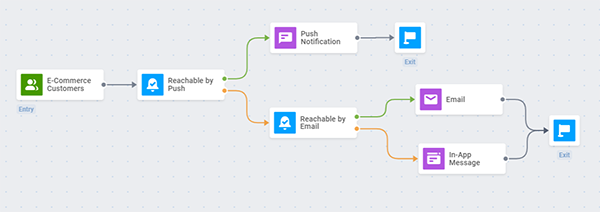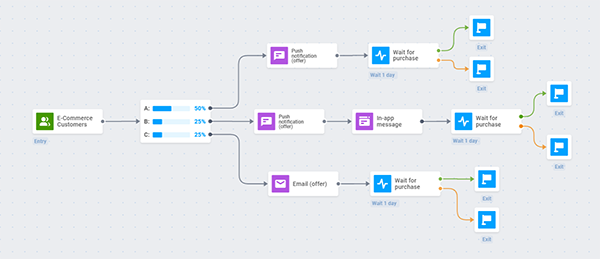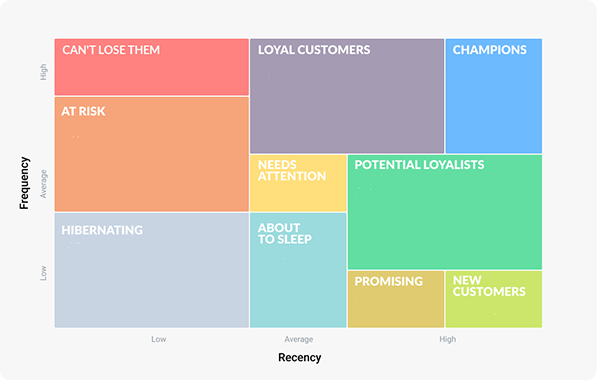Sponsor content is created on behalf of and in collaboration with Pushwoosh by DigitalCommerce360. Our editorial staff is not involved in the creation of the sponsored content.
No more champagne and special offers are all through; here we are, mobile marketers, feeling lost and feeling blue. The sad reality described in the iconic holiday song may sound too familiar to many e-commerce industry professionals. When the gift-buying rush is over, how can you retain your customers and maintain your revenue stream at a positive level? The answer comes in the form of omnichannel messaging. It can engage your audience daily, paving the way to long-term retention and higher customer lifetime value, as studies show.
Retain your newly-converted customers while you can
E-commerce customers are expectedly more active during the holiday season: special offers sent in push notifications gain peak 5–10% CTRs around Black Friday (as stated in the Pushwoosh research). A subsequent decrease in customer engagement is only natural, but as an e-commerce marketer, you want to do your best to keep your audience coming to your mobile store and making repeat purchases. If you succeed, you may secure 44% of revenue for your e-commerce business. How?
The odds for repeat conversions increase when you follow the customer on their online journey. In other words, meet your customers where they are — on the channels they are the most engaged with.
Add more channels to your messaging strategy
During the holiday season, you may care the most about delivering your special offers as swiftly as possible to as many customers as possible. For this job, push notifications are perfectly sufficient. But when the sales rush is over, you may need to engage your audience on a regular basis with various forms of messaging, such as:
- In-app messages — to be in touch with your audience when they are the most engaged, i.e. when they are actively using your app. On this channel, you may deliver personalized offers popping up in response to user behavior, make new products and brand announcements, and even experiment with engaging mechanics like in-app stories and wheel of fortune;
- Emails — to promote new items in your product range or distribute the same message you also sent via push notifications;
- WhatsApp and SMS — to ensure your news and offers reach every single user.
Adding more channels to your communication strategy creates extra touchpoints you may have with your customers. For even higher effectiveness, we recommend you:
Make these channels work in concert
You have to start somewhere with omnichannel messaging orchestration. We suggest you do it in three sets:
1. Unite multiple channels in one messaging flow
For example, a push notification with an offer may be followed by an in-app message with more detail. The purchase event may trigger sending a transactional push notification or SMS. And when the customer has received their order (and, hopefully, enjoys it), you may suggest a few ideas for their next purchase in an email newsletter.

An omnichannel messaging flow organized in Pushwoosh Customer Journey Builder
2. Double-check if your message has reached a particular customer
It would be a shame if you sent a great message, but it wasn’t delivered to the customer because they’ve opted out from your communications. Do a reachability check before sending a push notification or an email to ensure a user is available on these channels. If not, you can try to reach them via an alternative one.

Another risk is that a user doesn’t open the message for whatever reason. To avoid losing potential conversions, track push opens. If a customer doesn’t click on your notification, you may resend it via another channel — email.

3. Analyze and optimize your CTRs and conversions
Ideally, you should be able to get real-time statistics on your messaging performance at a glance (like you can in Pushwoosh Customer Journey Builder).
✔ Monitor the key metrics: CTRs of individual messages and conversion goals for your entire campaign;
✔ Do A/B/n testing to find an opportunity for improvement. Is a single push notification sufficient, or does the push + in-app message combination perform better? What converts better: the same offer in the form of a push notification or an email?

Leveraging the right channels is a significant part of a strategy, but it doesn’t end there. The next question is, what groups of customers are you going to target post-holidays?
Segment and analyze your customers
From our experience, behavioral segmentation works best: messages sent in response to specific events that users triggered receive 7x higher CTRs and result in 25x higher conversion into target action.
Ideally, before you even start your holiday campaign, you want to set up automated flows to gather user real-time behavioral data that you will use later.
You can also do a retrospective analysis, especially if it involves RFM segmentation. Determine your highest-value customers for this holiday season and strategize your further communications with them based on their RFM metrics.
Hint: your holiday shoppers are likely to be found in the Promising, New Customers, Potential Loyalist, and Champions segments.

Note: It is convenient to do RFM segmentation in the same tool you use for messaging campaign planning: there is no back-and-forth with data, and working in one interface is a breeze. Pay attention to this ability when choosing your next customer engagement platform or mobile messaging solution.
Personalize your messages
To increase clickability and real sales from your communications, take the personalized approach:
- Customize your message content based on particular user attributes and past behavior;
- Reach out to your audience via their favorite messaging channels — push/email open tracking and CTR analysis can help you determine which formats work best for specific users.
Retain your customers all year round with omnichannel messaging
Internal Pushwoosh research has found that in e-commerce, long-term retention correlates with daily user engagement: shopping apps with a high D30 Retention Rate also have a high percentage of Daily Active Users (DAU) in the base. And one of the most effective ways to boost DAU is through relevant messaging.
An e-commerce business that takes this idea seriously can retain up to 58% of its customers. Do you aim at the numbers as high as that?
Make omnichannel messaging part of your four-season strategy and enjoy a stable revenue flow throughout the year.
Author: Elena Kozlova
Content Marketing Manager @ Pushwoosh, the mobile-inspired customer engagement platform for high achievers. Using Pushwoosh’s tech-easy solutions, 80 000 e-commerce and non-e-commerce businesses have built effective communication strategies with the use of push notifications, in-app messages, emails, SMS, WhatsApp, and omnichannel triggered messaging.